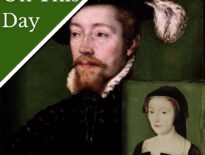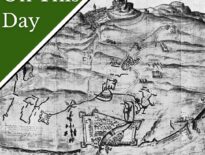On this day in Tudor history, 8th May 1539, in the reign of King Henry VIII, English troops mustered between Whitechapel and Mile End and then marched through the City and Westminster to St James's, where the king reviewed them.
This muster was in response to the war panic caused by Francis I and Charles V signing the Peace of Toledo.
Instructions had been given that only Englishmen who "had white harness and other accoutrements (described) and white caps with feathers" should go out and each alderman made sure that his men were equipped with swords and daggers.
The day started at 6am and the procession ended at 5pm. Guns were shot, the streets were crowded and people watched this "goodly sight" from their windows. It was a show of strength.
Here is a contemporary description of the Muster:
"Then on 8 May, before six in the morning, all were mustered in order of battle in the fields between White Chapel and Mile End. Each company "by hymselff rynged and swayled yn the felde"—a goodly sight, for all the fields were covered with men in bright harness from White Chapel to Mile End, and from Bednall Green to Ratclyff and Stepney. Describes the order of battle. About 8 a.m. they marched forward, the first "battle" led by 13 pieces of light ordnance on carts with powder and stone, followed by drums and fifers, and after them the standard of the city arms. Then came Mr. Sadler, alderman, captain of the guns, well horsed and in coat of black velvet, followed by the guns, five in a rank, ranks five feet apart, and every man's shoulder even with his fellow's, "which guns shot all together in divers places terribly, and especially before the King." Other details of the first "battle," in which marched Ralph Alen, captain of the archers, Mr. Wylford, captain of the pikes, and Sir Ric. Gresham, Sir Wm. Holleys, and Mr. Denham, captains of the bills. Then similar description of the second "battle," in which was the lord mayor in gilt harness, Sir Roger Cholmeley, recorder, with a massy chain, the surgeons of the city "yn whyte cotes with theyr bendes of whyte and grene, bawdryk wyse, and theyr splatters over the bene (which is theyr accustomed cognysance)," and the sheriffs. Then the third "battle."
They entered Aldgate before 9 a.m. and passed through the city to Westminster where the King and all the nobility stood and beheld the muster, before whom the great guns and hand-guns of every "battle" shot very terribly. They passed through the Great Sanctuary at Westminster round St. James's Park into St. James's Field; and then through Holborn to Chepe and Ledenhall, and so severed about 5 p.m. To see the numbers of lords, ladies, and gentlewomen at the windows, and how the streets were crowded, men would have thought that they that mustered had rather been strangers that citizens. They that numbered them can report what pains the wyffelers took to keep the soldiers in array, how rich the jewels, chains, and harness, what goodly, tall and comely men and how many they were; but those who tarried at home must also be reckoned, to show the whole puissance of the city.
Also on this day in Tudor history...
Source
- 'Letters and Papers: May 1539, 6-10', in Letters and Papers, Foreign and Domestic, Henry VIII, Volume 14 Part 1, January-July 1539, ed. James Gairdner and R H Brodie (London, 1894), pp. 436-441. British History Online http://www.british-history.ac.uk/letters-papers-hen8/vol14/no1/pp436-441.



Henry was probably quite right to mobilise troops although I’m not sure how they would go if someone like Charles V had his heart set on attacking England. Fortunately for the English, France and the Hapsburg empire were at it hammer and tongs soon after this invasion scare.